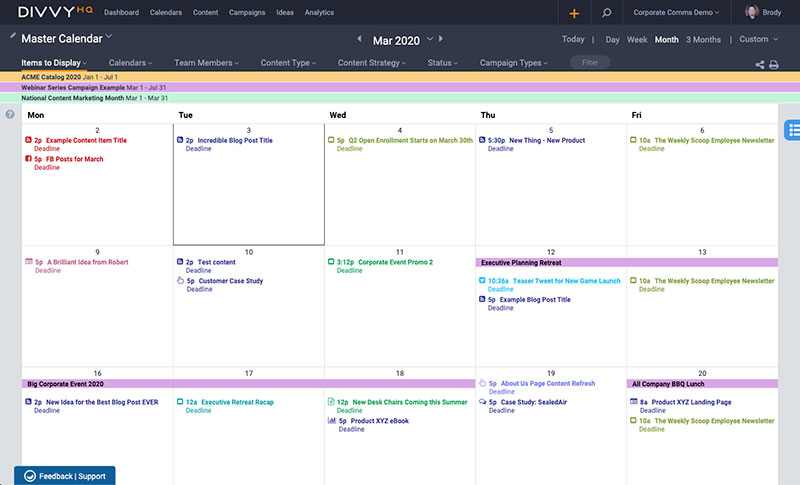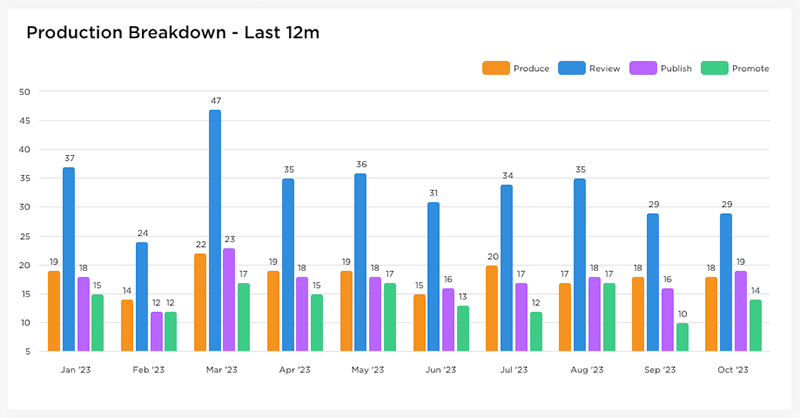You have deadlines to hit. Yet, complex people, technical, and process issues continually throw obstacles in your path. Pain points such as working with last-gen tech that isn’t interconnected, storing information across emails and spreadsheets, and low employee morale are common in our space, but how can you address all of these concerns to drive efficiency?
The truth is, it’ll take some work. Often, these issues are more interconnected than they may seem, and you can spend hours trying to manually parse out how different proposed solutions will impact your overall content operations.
However, the advent of the digital age has made refining these processes a competitive imperative. As more and more businesses embrace top-of-the-line technology to create and empower a unified workforce, like CRM solutions, content operations software, and AI-powered tools, organizations that do not adapt will be left behind.
You need to find a way to parse out the issues preventing you from scaling content production, and then you need to institute solutions that will create a connected, efficient workforce. Fortunately, if you’ve been looking for some guidance on how to do that, you’re in the right place.
In This Article:
Understanding Pain Points in Content Production
In content production, you’ll need to closely evaluate three areas to determine where you need to grow: People, Processes, and Technology.
People
How difficult is it to facilitate collaboration between teams, and what does collaboration look like on a day-to-day basis? If employees struggle to use any of your systems, identify what about their user experience is frustrating or inefficient.
It may also be helpful to identify how many members of your team are suffering the effects of burnout, why, and any steps you can take to accelerate recovery.
Processes
What does your workflow look like, and are there any particular points where it seems to slow down? Are there areas that could be streamlined? Take an audit of how much oversight you have into your employees’ day-to-day, and how often you are aware of when projects begin to stagnate. Conceptualize your dream workflow in both substance and execution.
Technology
What technology is being used to support your team’s day-to-day operations, and how well do different systems communicate with one another? Do your tools have the essential features required to perform their job well? It will also be helpful to identify areas where manual tasks can be automated.
What you’re essentially performing here is an operational audit: or to put it another way, understanding where and how your content production infrastructure is sabotaging your performance. By understanding where your team’s workflows are interrupted, you can then decide on a course of action that will streamline production and drive efficiency.
It may also be helpful to audit your competitors. Understanding what kinds of content they produce, what topics they tend to cover, and even how their content has evolved with the market can provide helpful insights as you re-evaluate your own content procedures.
Targeted Improvements: Addressing Pain Points One at a Time
Once you know what’s working and what isn’t, you can begin to take steps toward resolving these pain points. You should proceed strategically, with the understanding that this is a marathon, not a sprint. Change should be slow but steady, giving your employees enough time to adjust and adopt the new systems and processes and thoroughly reporting on the impact of each change before moving forward.
It’s also worth noting that, contrary to what some may tell you, you can’t invest your way out of change management. While you should embrace the many cutting-edge innovations out there and experiment with how they affect content, you cannot neglect the people and process components and expect success.
That being said, if you’re suffering in one or more of the three areas above, here are some measures you can test to resolve your pain points and unlock greater productivity.
Migrate and Centralize Your Data
CRM platforms are good for one thing: creating a single source of truth for sales and customer-facing employees across your organization. A content operations platform fulfills a similar role by centralizing content ideation, planning, and content production processes across marketing, communications, and content teams.
By migrating all of your data into one platform and integrating that platform with your company’s systems, you streamline communication, unlock greater opportunities for collaboration, and allow for high-level insight into your employees’ everyday workload.
Screenshot: DivvyHQ Calendar Interface
Analyze Your Content Production Workflows
As your content operation evolves and content publishing volume ramps up, it’s inevitable that workflow bottlenecks will arise. These issues could be simple things to fix, like stakeholders not being notified or missing notifications when they need to review the proof of a content asset. For those teams still using antiquated spreadsheets, we’re looking at you. A spreadsheet isn’t sending reminders to folks when deadlines are approaching.
Bringing on a more modern project management platform that has these standard features is crucial for efficient processes.
But your issues could be more complex. Certain content assets often require a thorough review from subject matter experts, compliance officers, or key executives. If a good portion of your content requires certain checks and balances, you need to account for that and build realistic time windows or SLAs (service level agreements) into your workflows.
Centralized data platforms can also help here. With the right platform, both macro and micro analysis of your production processes can be performed to spot common bottlenecks, whether that be certain people, or parts of your workflow that simply need more time.
Screenshot: DivvyHQ Analytics – Production Task Breakdown Report
Consider Using AI
Artificial intelligence has the potential to generate content, yes, but it also has a much wider scope of use cases. You can use AI-powered tools to spellcheck and suggest edits to copy, create summaries of interview transcripts and conference calls, and even proactively ideate and recommend content topics based on market trends.
Revisit Your Existing Content Strategy
Perhaps you’re running into an issue where your team is overcommitting energy to content that delivers minimal returns. While you want to be careful that you don’t fall into a cycle of constant re-evaluation (as that is a trap in itself), you can commit to testing new forms of content. Pivoting away from text-heavy assets to more snackable, visual assets can be a good way to increase overall production, while also providing readers with more valuable content.
There’s no wrong way to proceed; only what’s best for yourself, your team, and your organization’s bottom line. Test a wide variety of measures over time, carefully recording and documenting how each change affects productivity. While it will likely be a time-intensive process, when you crack the formula of high efficiency — well, your organization will be better positioned for success than ever before.
If you’re curious how DivvyHQ might be part of to solution to modernize your outdated content production processes, we’d love to talk. Request a demo today.



